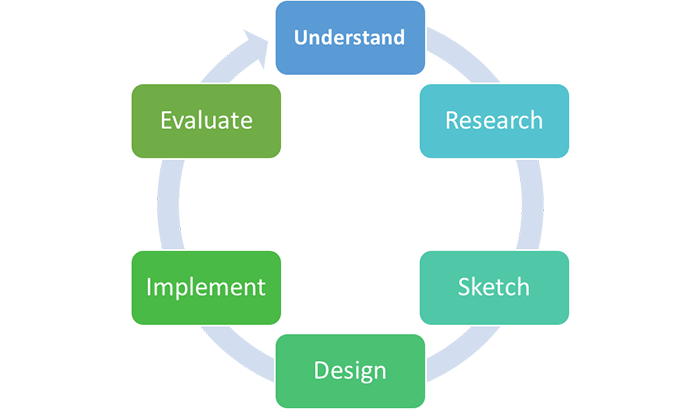| |
|
  |
| User Experience Design is that part of my identity, where I actively use my technical and creative mindset. My UX process is an iterative method, that helps me continuously improve and polish designs. I go through different stages repeatedly while evaluating designs at each level. |
| |
 |
 |
| 1. Understand |
 |
In order to provide a solution, its important to understand the problem. This phase includes:
Meeting, talking, observing and understanding users in their environment. Analyzing requirements to understand and clarify them. Defining user personas and use-cases.
Outcomes: User Personas, User Stories, Use Cases and User Flows. |
 |
|
  |
 |
| 2. Research |
 |
Research is the basic key step to design user experience. Study of competitors’ approaches,
research on similar features in the market place. Analysis of latest UI/UX trends, design principles and rules. Adhering to the user’s own UX guidelines.
Outcomes: A bunch of ideas and layouts options on which actual design work can be build. |
 |
|
 |
| 3. Sketch |
 |
Generate ideas and work on basic paper sketches, white board flows and wireframes, mockups to share ideas with stakeholders. Brainstorming sessions with stakeholders to get their feedback from a technical perspective. If required re-draw sketches and re-test them with stakeholders.
Outcomes: Sketches, Wireframes, Mockups, User flows. |
 |
|
 |
| 4. Design |
 |
After finalizing layout and flow of the required interface, the next step is to work on final graphics. Create initial mockups and wireframes with theme and styles applied to them. Preparing and sharing of design specifications to the development team.
Outcomes: Design images, Detailed design specs like colors, theme, styles, guidelines and
icons |
 |
|
 |
| 5. Implement |
 |
Implementing back-end functionality and front interface.
Outcomes:
Developed UI with complete functionality and experience following the designed theme and style |
 |
|
 |
| 6. Evaluate |
 |
| When product features are implemented, the end product is evaluated. It can be usability inspection, usability testing or A/B testing. |
 |
|
 |
| 7. Refine & Repeat |
 |
| The feedback from the testing is what drives the iterative process, giving essential insight into refining the prototype, rethinking the interaction, even generating more concepts. Refine & Repeat until desired user experience is achieved. |
 |
|
 |

